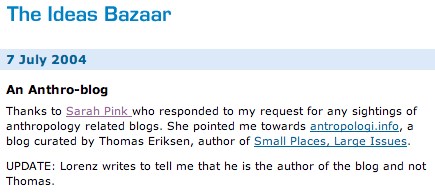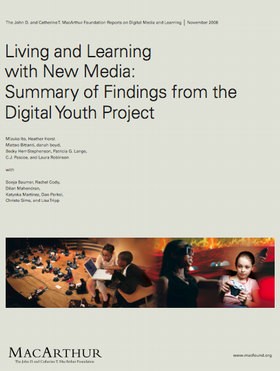It’s hard to believe that I have been running this blog already for around five years. It was in June 2004, I bought the domain antropologi.info and on the 7th of July 2004, the English blog was launched by anthropologist Simon Roberts from Ideas Bazaar who was the first one who found antropologi.info and blogged about it (see screenshot or the webarchive) – three weeks before I launched it officially in Norway (he is still blogging by the way).
There were only very few anthropology blogs at that time. So the news about a new anthropology blog spread fast. The same day, Dina Mehta, located in India, and Mónica Pinheiro in Portugal, blogged about it. Dina Mehta is still blogging, too, and was recently interviewed about her early blogging. And four days later, antropologi.info was mentioned on maybe the oldest anthropology blog, the ethno:log in Munich.
Blogging in 2004 (or even in 2005) was totally different from today. We were a very small anthroblog-community. There was no Savage Minds or Culture Matters. It was easy to stay up to date. People generally didn’t know what blogging was and rather looked upon it with suspicion. There was no web 2.0. Few used internet in their research and only few scholars published electronically. In 2004 there was no spam! I started with a simple blog script without any spam protection (see the old blog here)
My plan was creating an anthropology portal with both a news section, a calendar, link directory, forum, chat and some kind of magazine section – both in Scandinavian languages, in German and English. I found there is so much interesting research that should be wider known. I wanted to make anthropology more accessible – both to people outside and inside the university.
So I started scanning the news: But I also blogged about interesting posts by other bloggers. In the beginning, I wrote about every thesis that was posted online because this happened so rarely. I interviewed lots of people and also wrote some book reviews. I had lots of time as I just had quit my job. I missed my discipline. I tried to get up to date again, created this website and prepared possible phd-projects (that were never realised).
My first interview was with Eduardo Archetti (in Norwegian only) who died less than one year later. He had just returned from the largest European anthropology conference and I thought it must be exciting to know what knowlege was exchanged when so many anthropologists from all over Europe come together. Usually, this knowledge would remain unknown to the wider public.
I also tried to get anthropologists online, start blogging, publishing online (but only with limited success). I also offered free blogs on antropologi.info – one of the anthropologists is still blogging – Cicilie Fagerlid.
I interviewed some of the first anthrobloggers in 2005 about anthropology and the internet.
Things are very different now. Much has changed in a very short time. We have become a huge community. It is an amazing development! Many anthropologists have started blogging. In addition to pioneering sites like Savage Minds and anthropology.net, we now have several impressive group blog projects like Culture Matters, Material World, Neuroanthropology, Cognition and Culture, Somatosphere and more.
Blogging has become mainstream and blogs a central space for scholary communication.
One of the most impressive developments might be that mainstream organisations like the American Anthropological Association (AAA) and the Association of Social Anthropologists of the UK and Commonwealth (ASA) have started blogging. Today the AAA has one of the most active anthropology blogs. There are new posts nearly every day. Who would have thought that only one year ago?
Then, more and more papers and theses are published online, and the list of Open Access journals is growing. Some have started podcasting like the Society of Applied Anthropology (SfAA) or most recently The Informal Ethnographer (Alexandre Enkerli). German EVIFA has created an impressive anthropology online library (German / English).
Recently, Facebook has become a new arena for communication. Anthropologists are extremly active on twitter and the new Open Anthropology Cooperative has more than 1400 members.
I was once asked if the large number of blogs leads to competition. I answered that for me there are no competitors or rivals. Blogging is fun because there are so many other bloggers. It is because of the anthropology community (and the many friends I made via blogging), that I enjoy blogging and still do blog. Blogging in Norwegian for example is less fun than blogging in English. There is no Scandinavian anthrosphere online, and there is little interaction on the Norwegian blog.
So a big thank you to you who read these lines! Thanks also to everybody who sent papers and theses and contributed with book reviews, guest posts, articles and comments!
Nevertheless, the growing number of anthropological content online has also changed the content of this blog. Too much is happening, it is no longer possible to follow up and cover everything. But this overview feature is still available – on the “antropologi.info Newspaper site” http://www.antropologi.info/blog/ and http://www.antropologi.info/feeds/anthropology/
Feedback face to face, via email, links via other websites etc tell me that the website has been useful for anthropologists. But antropologi.info is not only visited by loyal readers. Most websites get the most traffic from occasional readers – via search engines like Google. I think it is funny to know that for example people who google something like “most primitive people” or “naked tribes” (happens several times a day) are directed to posts where I criticize the idea that there are primitive people. A few days ago, a Norwegian googled after a Norwegian doctor in Arguineguin (place in Spain where many Norwegians live) and then was directed to a blogpost about Norwegians in Spain not willing to integrate.
News travel fast. It was fascinating to see that few hours after I had published the news Anthropology in China: IUAES-conference boycott due to Uyghur massacre, the post was reposted on several Uyghur websites and even translated into Chinese. They weren’t regular readers. They either googled or used aggregators that notify them when new articles about Uyghur issues appeared online. Something similar (in much larger extend, though) might have happened to Maximilan Forte at Open Anthropology. His blog post on America’s Iranian Twitter Revolution received much attention. It was translated into Arabic and Farsi and even published by Al Jazeera. He was also interviewed by Egypt’s Al-Ahram Weekly.
Although it sometimes takes a week or more before a new blog post appears, I have no plans of stopping blogging. It might be necessary to stress that antropologi.info is a one-man project without any financial support. I say that because I often get emails that treat antropologi.info as an institution or organisation. I was for example asked if it was possible to visit antropologi.info’s office and an anthropologist in India even sent me a job application.
UPDATE: Thanks for congratulations and mentioning this post Savage Minds, Neuroanthropology, Erkan Saka, Kulturwissenschaftliche Technikforschung and somatosphere!



